
The Myrtles Plantation is a historic home and former antebellum plantation in St. Francisville, Louisiana, United States built in 1796 by General David Bradford. In the early history of the property, it was worked by enslaved people. It is reportedly a haunted place, and has been featured in television. The Myrtles Plantation has been listed on the National Register of Historic Places since 1978.
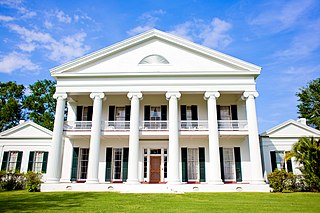
Madewood Plantation House, also known as Madewood, is a former sugarcane plantation house on Bayou Lafourche, near Napoleonville, Louisiana. It is located approximately two miles east of Napoleonville on Louisiana Highway 308. A National Historic Landmark, the 1846 house is architecturally significant as the first major work of Henry Howard, and as one of the finest Greek Revival plantation houses in the American South.

The Bishop Portier House is a historic residence in Mobile, Alabama, United States. It sits diagonally across from the Cathedral of the Immaculate Conception, and faces Cathedral Square. It is owned by the Roman Catholic Archdiocese of Mobile. The house, built c. 1834, is one of Mobile's best surviving examples of a Creole cottage with neoclassical details. It was listed on the National Register of Historic Places on February 26, 1970, and subsequently was added to the Historic Roman Catholic Properties in Mobile Multiple Property Submission also.

Rosedown Plantation State Historic Site is an 8,000-square-foot (740 m2) historic home and former plantation located in St. Francisville, Louisiana, United States. Built in 1835 by Daniel and Martha Turnbull, it is one of the most documented and intact plantation complexes in the Southern United States. It is known for its extensive formal gardens surrounding the house.

Nottoway Plantation, also known as Nottoway Plantation House is located near White Castle, Louisiana, United States. The plantation house is a Greek Revival- and Italianate-styled mansion built by enslaved African people and artisans for John Hampden Randolph in 1859, and is the largest extant antebellum plantation house in the South with 53,000 square feet (4,900 m2) of floor space.

Allen Grove is a plantation house and historic district located in Old Spring Hill, Alabama. The Greek Revival house was built for John Gray Allen in 1857 by David Rudisill. It is a two-story frame structure with a two-story front portico featuring square paneled columns. The roof is hipped with side dormers. In 1890 the rear facade was altered when a kitchen and pantry wing and a two-story back porch was added. The house and two other plantation buildings were added to the National Register of Historic Places on July 7, 1994, as a part of the Plantation Houses of the Alabama Canebrake and Their Associated Outbuildings Multiple Property Submission.
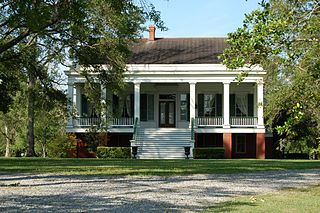
The St. George Plantation House, in Schriever, Louisiana was added to the National Register of Historic Places in 1982.
Cashpoint Plantation House, also formerly known as Ash Point and Woodlawn, is located shortly north of Louisiana Highway 71 between Taylortown and Elm Grove in Bossier Parish, Louisiana. It was built in about 1875 and added to the National Register of Historic Places on August 11, 1982.
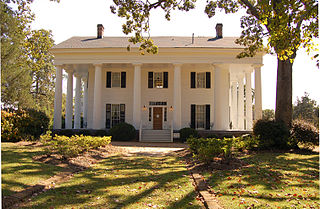
Antebellum architecture is the neoclassical architectural style characteristic of the 19th-century Southern United States, especially the Deep South, from after the birth of the United States with the American Revolution, to the start of the American Civil War. Antebellum architecture is especially characterized by Georgian, Neo-classical, and Greek Revival style homes and mansions. These plantation houses were built in the southern American states during roughly the 30 years before the American Civil War; approximately between the 1830s to 1860s.
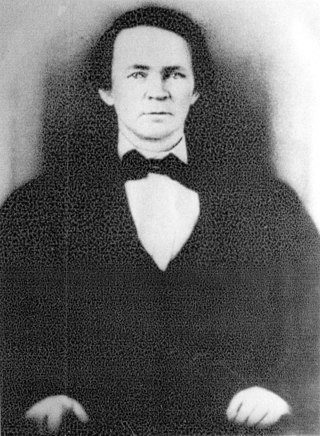
John Wind was an architect who designed his work in southwest Georgia in the United States from approximately 1838 until his death in 1863. He was born in Bristol, England, in 1819. John Wind designed the Greenwood, Susina, Oak Lawn, Pebble Hill, Eudora and Fair Oaks monumental plantation houses, the Thomas county courthouse and a few in-town cottages. William Warren Rogers writes "Some of Wind's work still exists and reveals him as one of the South's most talented but, unfortunately, least known architects." John Wind also worked as an inventor, jeweler, master mechanic and surveyor. He devised a clock that remained wound for one year and was awarded a patent for a cotton thresher and cleaner, Patent Number 5369. He was also the co-recipient of a corn husker and sheller patent in 1860. But it was his work and creations as an architect that made him an enduring figure that left a mark on society.

Willow Grove, also known as the Clark House, is a historic plantation house located near Madison Mills, Orange County, Virginia. The main brick section was built about 1848, and is connected to a frame wing dated to about 1787. The main section is a 2+1⁄2-story, six-bay, Greek Revival-style brick structure on a high basement. The front facade features a massive, 2+1⁄2-story, tetrastyle pedimented portico with Tuscan order columns, a full Tuscan entablature, an arched brick podium, and Chinese lattice railings. Also on the property are numerous 19th-century dependencies and farm buildings, including a two-story schoolhouse, a one-story weaving house, a smokehouse, and a frame-and-stone barn and stable.

Bocage Plantation is a historic plantation in Darrow, Ascension Parish, Louisiana, about 25 miles (40 km) southeast of Baton Rouge. The plantation house was constructed in 1837 in Greek Revival style with Creole influences, especially in the floorplan. Established in 1801, the plantation was added to the National Register of Historic Places on June 20, 1991.

Cherry Grove Plantation is a historic plantation in Natchez, Mississippi.
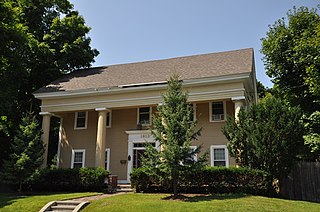
The William Rossiter House is a historic house at 11 Mulberry Street in Claremont, New Hampshire. Built in 1813 and enlarged by about 1850, it is a distinctive local example of Greek Revival architecture, with many surviving Federal period features. The house was listed on the National Register of Historic Places in 1979.
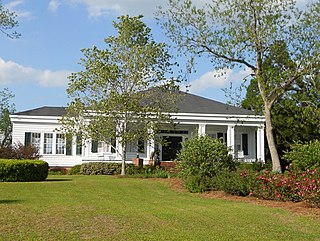
The Glenn–Thompson Plantation is a historic plantation house near Pittsview in Russell County, Alabama. The house was built in 1837, five years after the Treaty of Cusseta which ceded Muscogee lands to the United States. It was built by Massilon McKendree Glenn, son of the founder of nearby Glennville, and an academic who was the president of the Board of Trustees of the Glennville Female Academy. Glenn traded the house and its lands to a nearby planter named George Hargraves Thompson in 1840. Thompson developed the land into a working plantation, and his son, Willis, was one of the first in the area to convert his lands to produce pecans.

The Carville Historic District in Carville, Louisiana, is a 60-acre (24 ha) historic district that was listed on the National Register of Historic Places on November 18, 1992. It formerly served as a treatment facility for leprosy, and was called the National Leprosarium, Gillis W. Long Hansen's Disease Center and Public Health Service Hospital No. 66.
Sylvan Retreat, also known as the J. H. Pumphrey Home, is a historic raised former plantation house at 610 N. 3rd Street in Gibsland in Bienville Parish, Louisiana. It was built in 1848 by William George Walker in another location, and was moved into Giblsland in 1884. It was listed on the National Register of Historic Places in 1979.
Nichols House, near Ponchatoula, Louisiana, dates from around 1880. It was listed on the National Register of Historic Places in 1980.

Frithland is a large Colonial Revival-style house built in 1919 near Bunkie, Louisiana in Avoyelles Parish, Louisiana. It was listed on the National Register of Historic Places in 1985.
















